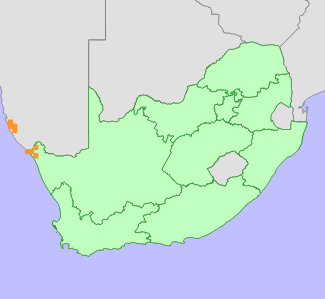|
Scientific Name | Polygala mossii Exell |
Higher Classification | Dicotyledons |
Family | POLYGALACEAE |
National Status |
Status and Criteria | Near Threatened* B1ab(iii,v)+2ab(iii,v) |
Assessment Date | 2015/05/01 |
Assessor(s) | L. von Staden |
Justification | A range-restricted species (EOO 1534 km²), occurring at fewer than 10 locations and declining due to ongoing habitat loss and degradation. As the South African population is continuous with the larger, more stable Namibian population, the national status is downgraded by one category following IUCN regional assessment procedures. |
Distribution |
Endemism | Not endemic to South Africa |
Provincial distribution | Northern Cape |
Range | South-western Namibia to the Richtersveld. |
Habitat and Ecology |
Major system | Terrestrial |
Major habitats | Central Richtersveld Mountain Shrubland, Western Gariep Lowland Desert, Western Gariep Plains Desert |
Description | Rocky slopes. |
Threats |
| This species is threatened across its range by habitat loss and severe degradation due to open cast mining. Mining expansion is not just causing ongoing habitat destruction, the negative impacts of mining disturbance spreads far beyond the mines due to windblown dust from exposed mine dumps being blown across the plains, burying dwarf species such as this one. Severe overgrazing is also causing ongoing degradation and a loss of species diversity across this species' range, but it can still be found in areas where there has been an almost complete loss of vegetation cover, such as the plains at the base of Helskloof, and it may be somewhat resilient to the effects of grazing. |
Population |
This species has a limited range in South Africa, where it occurs on the coastal plain between Alexander Bay and Helskloof, and the population is declining due to ongoing habitat loss and degradation. The South African population is continuous with Namibia, where this species is much more widespread and common, and not severely threatened. The South African population is likely to benefit from rescue effects from the adjacent Namibian population.
|
Population trend | Decreasing |
Assessment History |
Taxon assessed |
Status and Criteria |
Citation/Red List version | | Polygala mossii Exell | NT* B1ab(iii,v)+2ab(iii,v) | 2015.1 | | Polygala mossii Exell | Least Concern | Raimondo et al. (2009) | |
Bibliography |
Raimondo, D., von Staden, L., Foden, W., Victor, J.E., Helme, N.A., Turner, R.C., Kamundi, D.A. and Manyama, P.A. 2009. Red List of South African Plants. Strelitzia 25. South African National Biodiversity Institute, Pretoria.
Snijman, D.A. 2013. Plants of the Greater Cape Floristic Region 2: The extra Cape flora. Strelitzia 30. South African National Biodiversity Institute, Pretoria.
|
Citation |
| von Staden, L. 2015. Polygala mossii Exell. National Assessment: Red List of South African Plants version 2024.1. Accessed on 2025/11/20 |
 Comment on this assessment
Comment on this assessment


